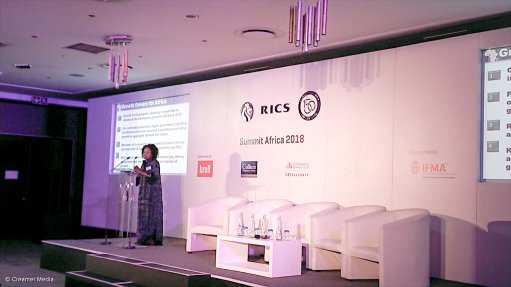
Imara Africa Consulting managing partner Barbara Barungi speaking at the Rics Summit Africa 2018
There are rapidly growing megacities, including Accra, Cairo, Lagos, Johannesburg, Nairobi and Kinshasa, in Africa, and it is important to ensure infrastructure development grows at a pace that will meet the increasing consumer demand that will come out of these megacities, said Imara Africa Consulting managing partner and macroeconomist Barbara Barungi.
She delivered the keynote address at the fourth yearly Royal Institution of Chartered Surveyors summit, which was held on Wednesday and Thursday.
Barung shed light on how the economic growth prospects will affect the macroenvironment and Africa’s development.
Global gross domestic product (GDP) grew by 3.7% in 2017 – with Africa being the second-fastest growing continent.
“The 3.7% GDP growth in Africa is cause for celebration, especially given that 2015 and 2016 saw the big economies – Nigeria and South Africa, as well as Egypt – slowing down,” Barungi said.
However, she noted that, to consider the context of this African growth, it is important to look at the various regions, rather than looking at Africa as a continent.
East Africa is expected to lead GDP growth in 2018 at 5.9%, with Rwanda, Tanzania, Kenya and Ethiopia being the fastest-growing economies in the region.
The predicted GDP growth for North Africa is 4.6%, with Egypt and Morocco being leading economies.
West Africa was hit by Nigeria’s recession, owing to the downturn in commodities affecting GDP and is, therefore, likely to grow at a slower pace than the rest of Africa at 3.4%, where growth will be aided by Senegal and Côte d’Ivoire.
Southern Africa has a lower predicted GDP growth rate at 2.5%, which is particularly influenced by the slow growth rate in South Africa.
Central Africa has a predicted GDP growth of 1.3% in 2018.
“Large economies are growing at a much slower pace than the smaller economies. East Africa is a region of small countries, compared with Southern Africa that has South Africa and Angola as big economies and Nigeria in West Africa,” averred Barungi.
She added that although it is good to see some of these regions growing at a faster rate, the question is how sustainable this growth will be and what drives the growth in these regions.
“The top fastest growing countries, including Ethiopia, Côte d’Ivoire, Rwanda, Senegal and Ghana are small economies, but what are the implications for the rest of the region? We need a spillover effect across the continent to ensure that we can sustain the growth over a longer period.”
Ethiopia has managed to sustain growth at 7% for at least the past five years.
“To what extent are policymakers looking at economic diversification away from commodities? We keep talking about increasing diversification of these economies to establish sectors around construction, agriculture and value chain development, and yet our economies are influenced by commodity prices.
“The question then is how best can we break away from this dependence?” Barungi questions, noting that Ethiopia is starting to show interesting developments in the manufacturing and construction sectors.
The rapid pace of construction in Addis Ababa has, to a great extent, brought more attention to how infrastructure development can be an engine of growth, and although whether the financing is sustainable remains a moot question, “it does not dispute the fact that infrastructure development should be an engine of growth in more of the African countries that we look at,” noted Barungi.
She further outlined the growth drivers for Africa going forward. With increasing urbanisation, growth is more focused around urban cities. Therefore, growth in consumption spending is expected to influence the continent’s growth in 2018 and 2019.
However, implications for inclusive growth need to be considered, especially taking into account people in rural areas, Barungi pointed out.
For commodity exporters, higher government spending on infrastructure and recurrent expenditures will drive growth in aggregate demand and output.
Recovery of commodity prices and structural reforms are expected to boost private investments; and key sectors such as crude oil and natural gas, mining, agriculture and services are the main engines of growth.